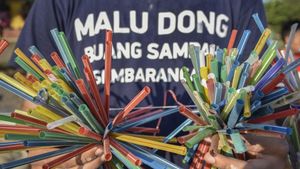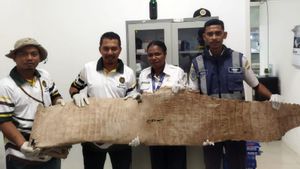JAKARTA - Suharto was born on June 8, 1921 in Kemusuk Hamlet, Argomulyo Village, Sedayu District, Bantul, Yogyakarta. Today is a hundred years or a century since his birth. What was Suharto's life like? Serving 32 years, Suharto recorded his name in a number of important historical moments. Anything? We collected some of them.
Suharto's parents were named Sukirah and Kertosudira. Suharto began his military career in 1942.
At that time he was accepted as a member of the Koninklijke Nederlands(ch)-Indische Leger (KNIL) army. Petrik Matanasi in the book Indigenous So Lieutenant of the KNIL was a Dutch East Indies army formed by the colonial government to face local resistance.
When the Dutch withdrew from Indonesia and power passed to Japan, Suharto joined the Japanese military unit, PETA. Before finally joining PETA, Suharto had experienced a gloomy period.
In 1942 Suharto had gambled. Suharto, who is known to be proficient in card games. Suharto often played mockery with Londo cards.
Cemeh is a gambling game with small cards, usually dominoes. In mockery, each player holds two cards. Meanwhile, what is meant by the londo card is playing.
In addition to his strong numeracy skills, Suharto also had a honed intuition. Capital is important in gambling.
"When I started playing with jokes, I only had 1 guilder in cash," said Suharto in his autobiography, Suharto: My Thoughts, Sayings, and Actions (1989).
Quoted from Tirto.id, Suharto at least won up to 50 guilders at that time. But Suharto did not spend the money on a whim.
Suharto used the money to meet his daily basic needs and "That money is what I used with Amat Sudono to return home," he said.
Love story with Mrs. Tien
Another interesting story of young Suharto is his love story with Siti Hartinah alias Tien Suharto alias Ibu Tien. Tien filled most of Suharto's life. There are many stories between the two.
Suharto and Tien first met in Wuryantoro, Wonogiri, Central Java when they were both teenagers. Tien and his family at that time did live there. Meanwhile, Suharto had just moved from Kemusuk Village in Yogyakarta to attend school.
In Wuryantoro Suharto lived at the house of his uncle, Prawirohardjo. As described in the MEMORI article entitled Pahit Manis The Love Story of Pak Harto and Bu Tien, it was at school that Suharto saw Tien, his younger classmate. He was made to fall in love by Tien.
According to the story of Suharto's half-brother, Probosutedjo, as recorded by Alberthiene Endah in Probosutedjo's Memoir Romantika: I and Mas Harto, Suharto even felt inferior because of differences in social status.
Tien, at that time was known as a young woman from the Mangkunegaran aristocracy. Several years later, when the war was raging, Suharto, who had already held the rank of lieutenant colonel, was met by his aunt, Prawirowihardjo's wife.
The aunt apparently took the initiative to match Suharto with Tien. Tit for tat. Their love finally anchored in a marriage which was held on December 26, 1947 in Surakarta.
Suharto's love for Tien was paid for with great loyalty. Reciprocated loyalty. The love between the two will last until death do them part. There is a heartbreaking story that happened when Tien died.
Tien died on April 25, 1996 at Pertamina Central Hospital. According to the official news, the dimpled woman died of a heart attack.
At that moment, this general's strong defense shield that was known for his decisiveness fell. Suharto even looked unsteady when his soulmate left him for good.
"Piye to, how come it can't be helped? (how can it not be helped?)" Suharto said when he faced the fact that he had just lost his wife as written in Pak Harto's book: The Untold Stories.
Military and political career controversy
1965-1966 Massacre
Suharto's military career development began to find a significant point after Indonesia's independence, precisely in the midst of the political turmoil in 1965. Controversial histories were recorded during those times. Suharto, who at that time held the rank of Major General, was said to have coordinated the massacre operations in the 1965-1966 period.
This was revealed through a number of documents that were included in a book entitled The Army and the Indonesian Genocide: Mechanics of Mass Murder, which was compiled by Jess Melvin, a historian from the Sydney Southeast Asia Centre.
According to him, referring to the document, it can be seen how "the military activated the military chain of command that had been established prior to October 1 (1965) to carry out what was described as an extermination operation."
"A state of martial law was imposed in Sumatra, where this command operates. On October 4, we now know the military went a step further, ordering civilians to join."
"On October 14, Yudha Room was created to coordinate this crackdown," the book reads.
This eradication operation was carried out through various chains of command, both territorially and structurally, starting from the Kodam, KOTI, RPKAD and Kostrad. "Everything was coordinated directly by Suharto at the center," Jess explained.
Overthrow Soekarno through Supersemar
Also in that period, Suharto recorded another great history: the birth of the 1966 March Eleven Order (Supersemar). Suharto's success in overcoming the 30 September 1965 Movement or commonly known as G30S/PKI led to him being assigned the task of being the Commander of the Operational Command to Restore Security and Order (Pangkopkamtib).
Suharto was then sworn in as Commander of the Indonesian Army. On Friday, March 11, 1966, President Soekarno chaired the meeting of the Enhanced Dwikora Cabinet (Cabinet of 100 Ministers) at the Merdeka Palace, Jakarta. However, President Soekarno left the trial early and was evacuated to the Bogor Palace by helicopter.
As described in the MEMORI article entitled Supersemar Released, Soekarno Overthrown, the Proclaimer flew with Deputy Prime Minister I Soebandrio and Deputy Prime Minister III Chaerul Saleh. The inauguration session was then closed by Deputy Prime Minister II Dr. J. Leimena who then followed to Bogor.

It is known that the reason for Soekarno's evacuation was because news spread that apart from the student demonstrations, there was a group of unidentified troops around Monas. The situation was then reported to Lieutenant General Suharto, who was not present at the trial, claiming to be sick. The absence of Suharto resulted in the troops not being dispelled.
Quoting Supersemar: History in Power by Hendra Kurniawan, published in Bernas Jogja, the three generals, namely Basuki Rachmat, Amir Machmud, and M. Jusuf, managed to make it to the Presidential Palace. They convinced Sukarno to issue an order to Lieutenant General Suharto to secure the situation or this letter was known as Supersemar.
The letter was then signed and then accepted by Lt. Gen. Suharto. Since then, Indonesia's political path has changed. Instead of bringing things in order, Suharto relied on Supersemar for other things. Within 24 hours of the signing of the letter, Suharto dissolved the PKI and arrested 15 ministers. Suharto is also known to have removed Sukarno's supporters from the circle of power.
Suharto slowly stripped Sukarno of power. Until finally managed to become the Second President of the Republic of Indonesia and ruled for 32 years.
Suharto's overthrow

May 21, 1998, precisely at 09.00 WIB was a turning point for the people of Indonesia. After serving for 32 years, President Suharto announced his resignation.
Before resigning, there were many actions and events that forced Suharto to leave his post. On May 12, there was the Trisakti Tragedy which killed four students during a demonstration.
Then, there was an action on May 18, 1998, where a mass of students succeeded in controlling the MPR/DPR building complex. The series of pressures pushed the neck of Suharto's power.
*Read other information about SOEHARTO or read other interesting articles from Detha Arya Tifada, Putri Ainur Islam and Yudhistira Mahabharata.
TODAY'S HISTORY MoreThe English, Chinese, Japanese, Arabic, and French versions are automatically generated by the AI. So there may still be inaccuracies in translating, please always see Indonesian as our main language. (system supported by DigitalSiber.id)









